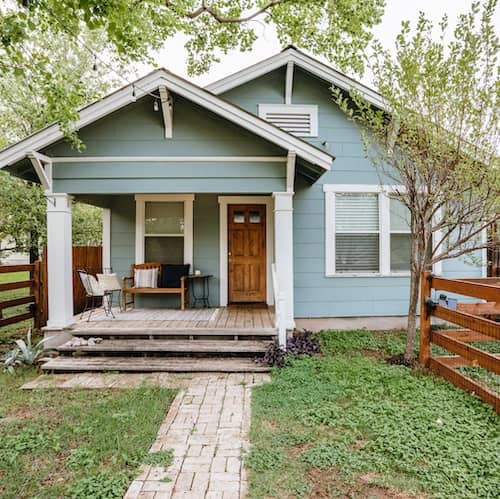What is an FHA mortgage insurance premium (MIP)?
Apr 9, 2024
•7-minute read

As of November 16, 2025, both Fannie Mae and Freddie Mac no longer have a minimum credit score threshold in their conventional loan eligibility guidelines. Loan approval will instead be based on an evaluation of overall credit risk factors.
An FHA loan is a type of mortgage that’s backed by the Federal Housing Administration (FHA). Compared to other mortgage options, FHA loans typically have more lenient standards for borrowers, like credit score and down payment requirements.
Unlike other types of loans, FHA loans require borrowers to pay a mortgage insurance premium (MIP). An FHA MIP is an additional payment you make to secure the mortgage loan.
Let’s take a look at FHA MIP and see how much you can expect to pay over certain loan terms.
What is a mortgage insurance premium?
A mortgage insurance premium is paid on FHA loans. It provides your mortgage lender with some protection in the event that you default on your loan. FHA MIP is beneficial to home buyers because, without it, lenders would likely require a much larger down payment in order to qualify for a mortgage.
How much is an FHA mortgage insurance premium?
Your FHA loan MIP will involve two payments: an upfront premium and an additional annual payment. The amount you’ll pay for both depends on your loan amount.
Upfront FHA MIP
Your upfront MIP payment will be equal to 1.75% of the total value of your loan. For example, if you borrow $150,000 for your mortgage, you’ll make an upfront payment of $3,500. The calculation looks like this:
$150,000 ? 1.75% (or 0.0175) = $3,500
Your upfront MIP payment is due when you close on your FHA loan. Alternatively, it can be added to the balance of the loan. Your upfront payment is only due once unless you refinance or take on another FHA loan in the future.
Annual FHA MIP
Your annual mortgage insurance premium costs will vary depending on your:
- Loan-to-value ratio (LTV)
- Size of your down payment
- Length of your mortgage term
- Base loan amount
Costs will vary depending on whether your base loan amount is greater than, less than or equal to $726,200, according to the FHA. Lenders calculate your annual payment as a percentage of your base loan value.
With a 10% or larger down payment on an FHA loan, you’ll pay MIP for the first 11 years. With less than 10%, MIP lasts the entire loan term.
Most lenders add MIP to your monthly mortgage payment. To find out how much yours will be, apply with a lender and receive a Loan Estimate once approved. To calculate it on your own, divide the annual MIP by 12 to estimate your monthly cost and see if it fits your budget.
FHA MIP for different loan term lengths
The length of time you’re paying off your FHA loan also affects the amount you’ll pay toward FHA MIP. Let’s take a look at how much your FHA mortgage insurance will be for loan terms less than or equal to 15 years and on FHA loans more than 15 years (like a 30-year FHA loan).
Bear in mind that the U.S. Department of Housing and Urban Development (HUD) reduced the annual FHA MIP by 30 basis points (BPS) as of February 2023. So, for FHA borrowers who were paying 80 basis points (or 0.80%) annually toward FHA MIP, they’re now paying 50 basis points (or 0.50%), and so on.
Terms greater than 15 years
Here’s what you can expect to pay if you have a loan term for longer than 15 years. The most common example of these types of loans is the 30-year term. Let’s say you borrow a mortgage that’s less than or equal to $726,200, where the loan term is greater than 15 years.
| For loans less than or equal to $726,200 | |||
|---|---|---|---|
| Down payment percentage | Annual fee |
Annual payment (Based on $300,000 home loan) |
Monthly payment (Approx.) |
| 10% or more | 0.50% | $1,500 (for the first 11 years) | $125 |
| 5% - 10% | 0.50% | $1,500 | $125 |
| Less than 5% | 0.55% | $1,650 | $137.50 |
If you take out an FHA loan that’s greater than or equal to $726,200 for a term that’s more than 15 years, here’s what you can expect to pay in FHA mortgage insurance:
| For loans greater than or equal to $726,200 | |||
|---|---|---|---|
| Down payment percentage | Annual fee |
Annual payment (Based on $800,000 home loan) |
Monthly payment ( Approx.) |
| 10% or more | 0.70% | $5,600 (for the first 11 years) | $466.67 |
| 5% - 10% | 0.70% | $5,600 | $466.67 |
| Less than 5% | 0.75% | $6,000 | $500 |
Terms less than or equal to 15 years
Here’s what you can expect to pay for your annual MIP if your loan term is less than or equal to 15 years, and you’re paying for an FHA loan that’s less than or equal to $726,200:
| For loans less than or equal to $726,200 | |||
|---|---|---|---|
| Down payment percentage | Annual fee |
Annual payment (Based on $300,000 home loan) |
Monthly payment (Approx.) |
| 10% or more | 0.15% | $450 (for the first 11 years) | $37.50 |
| Less than 10% | 0.40% | $1,200 | $100 |
If you borrow a loan that’s greater than or equal to $726,200 for a term that’s less than 15 years, here’s what you can expect to pay in FHA MIP:
| For loans greater than or equal to $726,200 | |||
|---|---|---|---|
| Down payment percentage | Annual fee |
Annual payment (Based on $800,000 home loan) |
Monthly payment (Approx.) |
| 22% or more | 0.15% | $1,200 (for the first 11 years) | $100 |
| 10% - 22% | 0.40% | $3,200 (for the first 11 years) | $266.67 |
| Less than 10% | 0.65% | $5,200 | $433.33 |
How long do you have to pay for FHA loan insurance?
Before 2013, MIP worked similarly to the private mortgage insurance (PMI) that you pay on conventional loans. Once you reach 22% equity in your home, a conventional mortgage lender automatically cancels your PMI.
Today’s FHA lenders no longer cancel your MIP once you reach a certain home equity percentage. The amount of time FHA borrowers will need to pay MIP depends on the down payment.
If you have at least 10% down at the time of your home purchase, you’ll pay MIP for the first 11 years. If you have less than 10% down at the closing table, you’ll pay MIP for the entire life of the loan.
How to avoid or lower your FHA mortgage insurance
There’s no way to completely avoid paying MIP when you take out an FHA loan. However, there are a few ways that you can lower what you pay or stop paying a few years into your loan.
Repeat or first-time home buyers can use a down payment of at least 10% to remove their FHA MIP after 11 years or choose a different type of loan to completely avoid this type of insurance. Homeowners can decide to refinance and change their FHA loan into a conventional mortgage to cancel their MIP payments.
Let’s take a closer look at each of these three methods so you can best decide what type of loan program would work best for you.
1. Save for a larger down payment
The easiest way to lower your MIP expenses with an FHA loan is to save more for a down payment. If you’re able to bring at least 10% to the closing table, you’ll qualify for a lower annual MIP payment. You’ll also lower the amount that you borrow, which results in a lower upfront premium. Plus, you can stop paying for MIP in 11 years if you have a 10% down payment.
2. Refinance to a conventional Loan
Many homeowners refinance to a conventional loan upon reaching 20% equity to eliminate MIP. Conventional loans don’t require MIP, though PMI applies if you have less than 20% equity. Refinancing allows you to stop paying MIP without switching to PMI.
Conventional loans have stricter requirements than FHA loans, so you may need to improve your borrower profile before refinancing. Below are the key factors needed to qualify.
Credit score
You must have a median FICO® Score of at least 620 to qualify for a conventional loan with most mortgage lenders, including Rocket Mortgage®. Making your credit card and loan payments on time and limiting your spending can help you increase your credit score while you build equity.
Debt-to-income ratio (DTI)
You must have a debt-to-income ratio (DTI) of 50% or less to qualify for a conventional loan. You can decrease your DTI by increasing your household income, paying down your debts or adding a co-signer with a lower DTI to the mortgage loan.
Home equity
You should have at least 20% equity in your home before you refinance from an FHA loan to a conventional loan. If you refinance before you have 20% equity, you’ll need to pay for PMI instead of MIP. PMI is more expensive than MIP, so be sure you have the right amount of equity before you refinance.
If you aren’t sure how much equity you currently have, contact your lender.
3. Choose a different government loan type
If you really want to avoid MIP payments, you may want to consider another type of government loan or non-conforming loan. We’ve broken down these options for you below:
USDA loan
You may be buying a home in a rural area and have a median FICO® Score of 640 or higher. In that case, why not consider a U.S. Department of Agriculture (USDA) loan? Unlike an FHA loan, USDA loans don’t require a down payment. You also don’t need to pay PMI or MIP with a USDA loan. Instead, you pay a monthly guarantee fee that’s less expensive than the FHA monthly premium.
Rocket Mortgage doesn't offer USDA loans at this time.
VA loan
VA loans are available for current or former service members and qualifying spouses. While the VA has no minimum credit score, most lenders require one—Rocket Mortgage requires a median FICO® Score of 580.
VA loans require no down payment or monthly mortgage insurance but include a one-time funding fee as part of closing costs.
The home must be your primary residence. Veterans receiving VA disability benefits and surviving spouses of veterans who died in service or from service-connected disabilities are exempt from the funding fee.
The bottom line: Is PMI on FHA loans required?
When you take out an FHA loan, you must pay an upfront mortgage insurance premium at the time of closing, plus an annual MIP, which will be divided into 12 monthly payments. The amount you’ll pay depends on the size of your loan and your down payment. The larger your down payment, the less you’ll pay annually.
You can’t cancel MIP payments on an FHA loan, but there are ways to avoid or lower your FHA MIP payment – like making a larger down payment or refinancing to a conventional loan.
If you’re ready to apply for your mortgage or a refinance, start your application online today with Rocket Mortgage.

Victoria Araj
Victoria is a former Team Leader of editorial content at Rocket Mortgage and she held roles in mortgage banking, public relations and more in her 19+ years with the company. She holds a bachelor’s degree in journalism with an emphasis in political science from Michigan State University, and a master’s degree in public administration from the University of Michigan.
Related resources

7-minute read
Mortgage insurance premium (MIP) vs. private mortgage insurance (PMI): How do they differ?
As you learn more about mortgage insurance, you’re likely to encounter two acronyms: MIP and PMI. We'll break down how they each work and their key dif...
Read more
4-minute read
A guide to the FHA MIP refund chart
Borrowers who refinance their FHA loan within 3 years may be eligible for a refund. Read here to understand the FHA MIP refund chart and what you may get bac...
Read more

6-minute read
What are the FHA loan down payment requirements?
FHA loans require a 3.5% down payment with a 580 credit score and 10% down with a 500 score. Explore how FHA loan down payment requirements work.
Read more